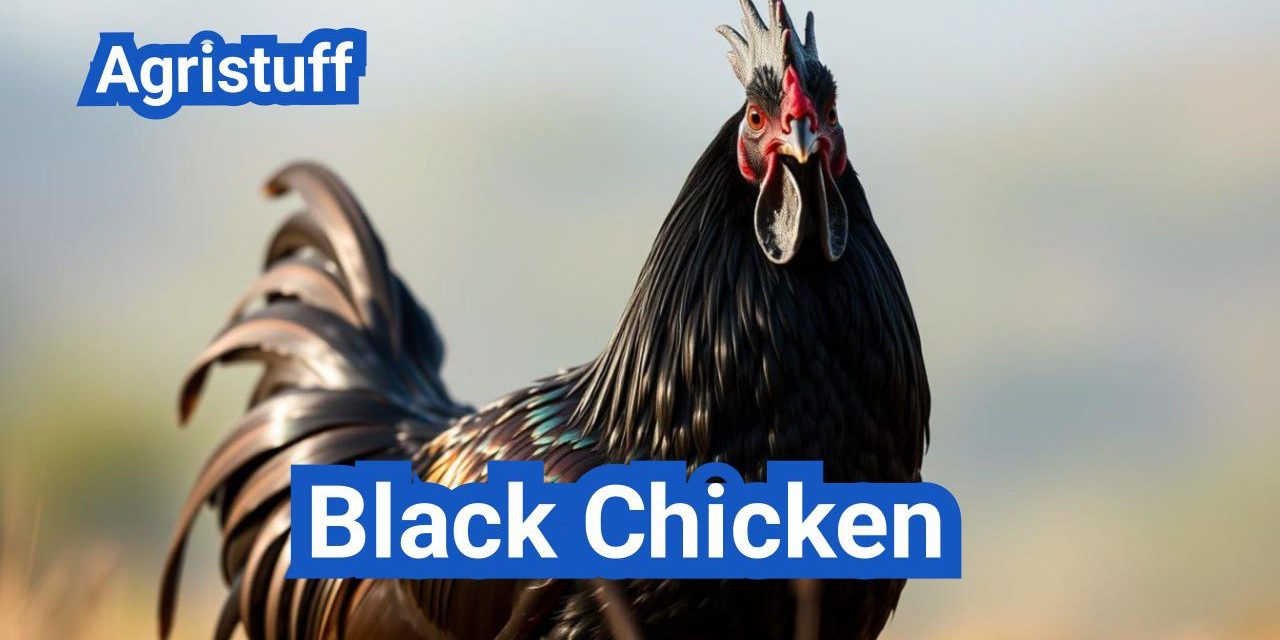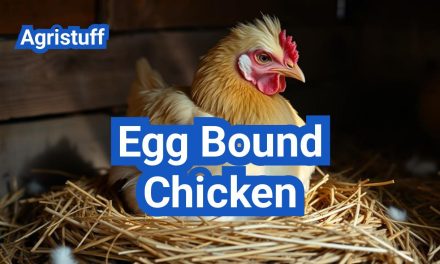The Ayam Cemani ( All Black Chicken ) is a rare and exotic poultry breed originating from Indonesia, known for its striking all-black features, including feathers, skin, and internal organs. This unique characteristic makes it a standout addition to any flock.
This breed is not only prized for its aesthetic appeal but also for its fascinating genetic makeup. The Ayam Cemani’s all-black trait is a result of a genetic condition known as fibromelanosis, which causes an excessive production of melanin.
Key Takeaways
- Ayam Cemani is a rare breed from Indonesia.
- It is known for its all-black features, including feathers, skin, and internal organs.
- The breed’s unique trait is due to a genetic condition called fibromelanosis.
- Ayam Cemani is prized for its aesthetic appeal and genetic uniqueness.
- It makes a stunning addition to any flock.
The Fascinating World of Ayam Cemani
The Ayam Cemani, known for its striking all-black appearance, is a breed that has fascinated poultry enthusiasts worldwide. This rare and exotic breed is not just a novelty; it carries a unique genetic trait that sets it apart from other chickens.
The Ayam Cemani’s allure is deeply rooted in its extraordinary genetic makeup, particularly the condition known as fibromelanosis. This genetic phenomenon is responsible for the hyperpigmentation that makes the Ayam Cemani entirely black, from its feathers to its internal organs.
What Makes These Chickens Special | All Black Chicken
Ayam Cemani chickens are considered special for several reasons. Firstly, their unique appearance is a major draw. The breed’s all-black coloration, including its feathers, beak, tongue, and even internal organs, is a result of the genetic condition fibromelanosis. This characteristic makes them stand out among other breeds.
The Phenomenon of Fibromelanosis | All Black Chicken
Fibromelanosis is a genetic condition that causes an excessive production of melanin, resulting in the Ayam Cemani’s signature black coloration. This condition is not just a superficial trait; it affects the bird’s internal organs and tissues, making it a truly unique specimen in the poultry world.
Understanding fibromelanosis is key to appreciating the Ayam Cemani breed. It’s a complex genetic trait that has been selectively bred to achieve the desired level of hyperpigmentation. Breeders and enthusiasts alike are drawn to the Ayam Cemani not just for its appearance, but for the genetic marvel that it represents.
Origin and History of the Ayam Cemani

The Ayam Cemani, known for its striking all-black appearance, has a rich history that originates from the island of Java, Indonesia. This breed has been a part of Indonesian culture for centuries, revered not only for its unique appearance but also for its cultural and spiritual significance.
Indonesian Heritage and Cultural Significance | All Black Chicken
In Java, the Ayam Cemani is considered a symbol of good luck and prosperity. It is often used in traditional ceremonies and is believed to possess mystical powers. The breed’s entirely black color, from its feathers to its internal organs, is associated with the mysterious and the sacred. The Ayam Cemani’s cultural significance extends beyond its physical appearance, representing a connection to the heritage and traditions of the Indonesian people.
The breed has been bred for centuries in Java, where it is highly valued. Its unique characteristics have made it a subject of interest and reverence, not just as a domesticated animal but as a part of the cultural fabric.
Introduction to the Western World | All Black Chicken
The Ayam Cemani was introduced to Europe in 1998, marking the beginning of its global journey. Since then, it has gained popularity among poultry enthusiasts and breeders worldwide, including in the United States. The breed’s exotic appearance and unique characteristics have made it a sought-after addition to many backyard flocks and breeding programs.
As the Ayam Cemani gained international recognition, efforts were made to preserve its genetic purity and cultural heritage. Breeders and enthusiasts have worked together to promote the breed, sharing knowledge and best practices for its care and breeding.
Today, the Ayam Cemani is recognized as one of the most exotic and rare chicken breeds in the world, captivating the imagination of many with its mysterious allure and cultural significance.
Understanding the All Black Chicken: Physical Characteristics
The Ayam Cemani chicken is renowned for its striking all-black appearance, a trait that sets it apart from other breeds. This unique characteristic is not limited to its feathers; it extends to its beak, tongue, comb, wattles, legs, and even its internal organs.
The Complete Black Appearance | All Black Chicken
The Ayam Cemani’s black appearance is due to a condition known as fibromelanosis, which causes an excessive production of melanin. This results in the hyperpigmentation of its skin, feathers, and internal organs, giving it a distinctive all-black look. The intensity of the black color can vary slightly among individuals but remains a defining characteristic of the breed.
Size, Weight, and Body Structure | All Black Chicken
Ayam Cemani chickens are of medium size. Roosters typically weigh between 3.5 to 4.5 pounds (1.6 to 2 kg), while hens weigh slightly less, ranging from 3 to 3.5 pounds (1.4 to 1.6 kg). They have a compact, muscular body with a broad breast and well-developed wings. The tail is carried high, adding to their elegant appearance.
Temperament and Behavior | All Black Chicken
Ayam Cemani chickens are known for their calm and docile nature, making them a great addition to many flocks. They are friendly, curious, and can become quite tame with regular handling. Their temperament, combined with their unique appearance, makes them a favorite among poultry enthusiasts. They are also relatively quiet and can adapt well to various living conditions, provided they are given adequate space and care.
How to Identify a Pure Ayam Cemani

Identifying a pure Ayam Cemani requires a keen eye for detail and an understanding of the breed’s unique characteristics. With the increasing popularity of this rare chicken breed, it’s becoming more challenging to distinguish between authentic, purebred Ayam Cemani and imitations or crossbreeds.
Visual Indicators of Authenticity | All Black Chicken
A pure Ayam Cemani is characterized by its all-black appearance, which includes not just its feathers, but also its beak, tongue, comb, and even internal organs. To verify the authenticity of an Ayam Cemani, look for the following visual indicators:
- Complete Black Pigmentation: Every part of the chicken, from feathers to beak, should be black.
- Consistent Coloration: The black color should be consistent across the bird, with no other colors visible.
- Physical Structure: Ayam Cemani chickens have a medium size and a well-proportioned body.
Common Imitations and Crossbreeds | All Black Chicken
Not all chickens sold as Ayam Cemani are purebred. Some may be crossbreeds or other black chicken breeds that resemble Ayam Cemani. Common imitations include:
- Svart Hona: While also black, Svart Hona has different origins and some physical distinctions.
- Silkie Chickens: Silkies can be black, but they have a fluffy, soft texture to their feathers, unlike the Ayam Cemani.
- Crossbreeds: Some breeders may cross Ayam Cemani with other breeds, resulting in chickens that are not pure.
To ensure you’re purchasing a pure Ayam Cemani, it’s crucial to buy from reputable breeders who can provide lineage information and guarantee the purity of the breed.
Ayam Cemani vs. Other Black Chicken Breeds
While several black chicken breeds exist, the Ayam Cemani is distinct due to its fibromelanosis trait, a genetic condition causing an excessive production of melanin, resulting in its all-black appearance, including internal organs and bones.
The Ayam Cemani is often compared to other black chicken breeds, such as the Svart Hona, Silkie, Black Java, and Sumatra chickens. Each of these breeds has unique characteristics that set them apart from one another.
Svart Hona and Silkie Chickens | All Black Chicken
The Svart Hona, also known as the Swedish Black Chicken, is another breed with a predominantly black appearance. However, unlike the Ayam Cemani, the Svart Hona’s black coloration is not as consistent, and they may have some variation in their feathering.
Silkie Chickens, on the other hand, are known for their fluffy, soft feathers and friendly temperament. While they come in a variety of colors, including black, their appearance is distinctly different from the sleek, glossy feathers of the Ayam Cemani.
Black Java and Sumatra Chickens | All Black Chicken
The Black Java chicken is an American breed known for its robust build and black plumage. Although it shares the black coloration with the Ayam Cemani, it lacks the latter’s internal black organs and bones.
Sumatra Chickens are known for their agility and striking black plumage with a green sheen. They are primarily kept for their ornamental value and are distinct from the Ayam Cemani in terms of their body structure and behavior.
Key Differences Between Fibromelanistic Breeds | All Black Chicken
The key difference between the Ayam Cemani and other black chicken breeds lies in its fibromelanosis. This trait is not as pronounced or is entirely absent in other breeds, making the Ayam Cemani unique.
| Breed | External Appearance | Internal Organs | Fibromelanosis |
|---|---|---|---|
| Ayam Cemani | All black | All black | Present |
| Svart Hona | Mostly black | Not all black | Absent |
| Silkie | Black (fluffy) | Not all black | Absent |
| Black Java | Black | Not all black | Absent |
| Sumatra | Black with green sheen | Not all black | Absent |
How to Set Up Your Space for Ayam Cemani
To keep your Ayam Cemani thriving, it’s essential to design a coop and run that meets their specific needs. Ayam Cemani chickens require a safe and healthy environment to flourish.
Housing Requirements and Coop Design | All Black Chicken
The coop is a critical component of your Ayam Cemani’s living space. It should provide protection from the elements and predators. When designing the coop, consider the size, ventilation, and ease of cleaning. A well-designed coop will help keep your chickens healthy and reduce the risk of disease.
Key Considerations for Coop Design:
- Ensure adequate ventilation to prevent ammonia buildup from droppings.
- Provide enough space for your chickens to roost comfortably. A general rule is to allow at least 3-4 square feet per chicken inside the coop.
- Design the coop with ease of cleaning in mind. This may include features like removable nesting boxes or a droppings board.
Climate Considerations and Predator Protection | All Black Chicken
Ayam Cemani chickens, like all breeds, need protection from extreme weather conditions and predators. In colder climates, ensure the coop is well-insulated to keep your chickens warm. In hotter climates, provide shading and ventilation to prevent heat stress.
Predator Protection Measures:
| Predator | Protection Measure |
|---|---|
| Foxes | Hardware cloth around the run, extending at least 12 inches below ground |
| Raccoons | Secure latches on coop doors, as raccoons are skilled at opening simple latches |
| Hawks and Owls | Cover the top of the run with netting or chicken wire |
By carefully planning the housing and coop design for your Ayam Cemani, you can create a safe and healthy environment that allows them to thrive.
Feeding and Nutrition Guide for Ayam Cemani

A well-planned nutrition strategy is essential for the optimal health of Ayam Cemani chickens. A balanced diet is crucial for maintaining their overall health, ensuring they thrive and exhibit their characteristic all-black appearance.
Daily Dietary Requirements | All Black Chicken
Ayam Cemani chickens require a diet rich in proteins, vitamins, and minerals. Their daily dietary needs include:
- High-quality commercial chicken feed as the main staple
- Fresh fruits and vegetables as supplements
- Adequate calcium for strong eggshell production
- Access to clean, fresh water at all times
The nutritional requirements may vary depending on the age and health status of the chickens. For instance, laying hens require more calcium to support eggshell production.
Supplements and Treats for Optimal Health | All Black Chicken
In addition to their regular diet, Ayam Cemani chickens can benefit from various supplements and treats. These include:
| Supplement/Treat | Benefits | Frequency |
|---|---|---|
| Oyster shells | Calcium supplement for strong eggshells | Free choice |
| Mealworms | High protein treat | 1-2 times a week |
| Leafy greens (kale, spinach) | Rich in vitamins and minerals | Daily |
It’s crucial to provide a balanced mix of these supplements to avoid nutritional deficiencies. Over-supplementation can be harmful, so it’s essential to strike the right balance.
Ayam Cemani chickens that receive a well-rounded diet are more likely to have vibrant health and exhibit their characteristic robust appearance.
Day-to-Day Care and Health Maintenance

The unique characteristics of Ayam Cemani chickens demand specific day-to-day care and health maintenance routines. Ensuring their overall health is crucial for their well-being and longevity.
Regular Health Checks and Monitoring | All Black Chicken
Regular health checks are vital for preventing and managing health issues in Ayam Cemani chickens. Monitoring their behavior, appetite, and physical condition daily can help identify potential health problems early.
- Check for signs of illness, such as lethargy, loss of appetite, or unusual droppings.
- Inspect their feathers, beaks, and claws for any damage or abnormalities.
- Monitor their breathing and watch for signs of respiratory distress.
Common Health Issues and Prevention | All Black Chicken
Ayam Cemani chickens, like other breeds, are susceptible to certain health issues. Understanding these common problems and taking preventive measures can help maintain their health.
| Health Issue | Symptoms | Prevention |
|---|---|---|
| Respiratory Infections | Coughing, sneezing, labored breathing | Provide a clean, dry coop; ensure good ventilation |
| Parasites | Weight loss, feather loss, lethargy | Regularly inspect for mites and lice; use dust baths |
| Reproductive Issues | Egg binding, prolapse | Provide a balanced diet; ensure adequate calcium |
Preventive measures such as vaccinations, parasite control, and a balanced diet can significantly reduce the risk of common health issues.
By following these guidelines and staying vigilant, you can help ensure the health and well-being of your Ayam Cemani chickens.
Understanding Ayam Cemani Eggs

While Ayam Cemani chickens are renowned for their all-black features, their egg-laying abilities are also noteworthy. The eggs laid by these chickens are an essential aspect of their breeding and raising.
Egg Characteristics and Production Rate | All Black Chicken
Ayam Cemani chickens lay white eggs, which might be a surprise given their all-black appearance. The egg production rate of Ayam Cemani chickens is relatively low compared to other breeds. On average, a healthy Ayam Cemani hen can lay around 100 to 120 eggs per year.
The eggs are not only a product of the chicken but also a crucial element in breeding programs. Understanding the characteristics of these eggs, such as their size, shape, and shell quality, is vital for successful hatching.
Incubation and Hatching Tips | All Black Chicken
Incubating Ayam Cemani eggs requires careful attention to detail. The incubation period for these eggs is similar to other chicken breeds, lasting about 21 days. Maintaining the right temperature and humidity levels is crucial for successful hatching.
Here are some key considerations for incubating Ayam Cemani eggs:
- Temperature: Maintain a consistent temperature of 99-100°F.
- Humidity: Keep the humidity level at 50-60% for the first 18 days and increase it to 70% for the final days.
- Turning: Eggs should be turned regularly to prevent the yolk from sticking to the shell.
Successful incubation and hatching depend on these factors, and careful monitoring can significantly improve the chances of healthy chicks.
To further illustrate the characteristics of Ayam Cemani eggs and their production, let’s examine the following table:
| Egg Characteristic | Description | Average Value |
|---|---|---|
| Egg Color | White | N/A |
| Annual Egg Production | Number of eggs laid per year | 100-120 |
| Incubation Period | Days required for hatching | 21 |
Raising Ayam Cemani Chicks Successfully

The journey of raising Ayam Cemani chicks begins with creating a suitable brooding environment. This initial stage is crucial for their development and long-term health.
Brooding Requirements | All Black Chicken
Brooding is a critical period in a chick’s life, typically lasting between 4 to 6 weeks. To ensure the Ayam Cemani chicks grow healthily, the brooder must be equipped with the right temperature, humidity, and lighting. The temperature should be around 90-95°F (32-35°C) during the first week and reduced by 5°F (-3°C) each subsequent week until it reaches the ambient temperature.
Key brooding requirements include:
- A clean, dry, and draft-free brooder
- Adequate ventilation to prevent ammonia buildup from chick droppings
- Appropriate bedding such as pine shavings or paper-based products
- A reliable heat source, such as a heat lamp or heat mat
Week-by-Week Development Guide | All Black Chicken
Monitoring the growth and development of Ayam Cemani chicks is essential. Here’s a week-by-week overview:
- Week 1: Chicks will start to fluff out and become more active.
- Week 2-3: Feathers begin to replace down, and they start to explore their surroundings.
- Week 4-6: Chicks will have most of their feathers and start to look like miniature adults.
Integration with Existing Flocks | All Black Chicken
Integrating new Ayam Cemani chicks with an existing flock requires patience and careful planning. It’s recommended to wait until the chicks are at least 6 weeks old and have reached a similar size to the existing flock members to minimize pecking and stress.
Tips for successful integration:
- Keep the new chicks separated but visible to the existing flock for a few days before introducing them directly.
- Monitor the flock’s behavior closely during the integration process.
- Provide enough space and resources to reduce competition.
The Unique Properties of Ayam Cemani Meat

The Ayam Cemani’s meat is renowned for its distinct characteristics, making it a delicacy in various cultures. This unique appeal is not just due to its entirely black appearance but also its believed health benefits and rich culinary history.
Characteristics of Black Meat | All Black Chicken
Ayam Cemani meat is known for its fibromelanosis, a condition that causes an excessive production of melanin, resulting in its black color. This characteristic not only makes the chicken visually striking but also contributes to its meat’s unique texture and potentially its nutritional profile.
The black meat is believed by many to have higher protein content and lower fat compared to regular chicken meat.
Culinary Uses and Traditional Recipes | All Black Chicken
Ayam Cemani meat is used in various traditional dishes, particularly in Indonesian cuisine. It’s often used in soups, stews, and braises where its unique flavor and texture can be appreciated.
One traditional recipe involves slow-cooking the chicken in a rich broth with local spices, enhancing its natural flavors. The meat is also believed to have medicinal properties, making it a sought-after ingredient in certain cultural practices.
- Used in traditional Indonesian soups and stews
- Slow-cooked with local spices to enhance flavor
- Believed to have medicinal properties
The Economics of Owning All Black Chickens

For those drawn to the mystique of the all-black chicken, understanding the economics is crucial. The Ayam Cemani, known for its stunning appearance, comes with a significant price tag due to its rarity and the challenges associated with breeding.
Understanding Ayam Cemani Prices | All Black Chicken
The cost of an Ayam Cemani can vary widely based on factors such as location, breeder reputation, and the chicken’s quality. Generally, prices can range from a few hundred to several thousand dollars per bird.
| Factor | Impact on Price |
|---|---|
| Breeder Reputation | Higher reputation breeders charge more for their birds due to the quality and purity of the breed. |
| Location | Prices can vary by region due to differences in demand and local breeding costs. |
| Chicken Quality | The purity and physical characteristics of the Ayam Cemani affect its price, with higher quality birds commanding higher prices. |
Initial Investment and Ongoing Costs | All Black Chicken
Owning an Ayam Cemani involves more than just the initial purchase price. There are costs associated with housing, feeding, and healthcare that need to be considered.
Initial Costs: Purchasing the chicken, coop setup, and initial feed supply.
Ongoing Costs: Feed, healthcare, and potentially breeding expenses for those interested in raising chicks.
Potential Returns for Breeders | All Black Chicken
For those interested in breeding Ayam Cemani, there is potential for profit, especially if they can produce high-quality, purebred chicks. However, this requires a significant investment of time, money, and expertise.
Breeding Ayam Cemani for profit involves not just selling chicks but also potentially selling breeding stock to other enthusiasts. The key is to maintain the genetic purity and quality of the breed.
Where and How to Buy Authentic Ayam Cemani

Purchasing Ayam Cemani from reputable sources is vital for the health and authenticity of the chickens. With their unique appearance and cultural significance, it’s no wonder that many enthusiasts are eager to add these birds to their flocks.
Reputable Breeders in the USA | All Black Chicken
Finding a trustworthy breeder is the first step in acquiring authentic Ayam Cemani. Reputable breeders in the USA can be found through various channels, including:
- Poultry associations and clubs
- Online marketplaces specializing in rare breeds
- Agricultural shows and events
- Referrals from other breeders or enthusiasts
When searching for breeders, it’s essential to do your due diligence. Look for breeders who are transparent about their breeding practices, provide health guarantees, and are willing to answer questions.
Questions to Ask Before Purchasing | All Black Chicken
Before buying Ayam Cemani, there are several questions you should ask the breeder to ensure you’re getting healthy, authentic birds:
- What is the lineage of the chickens, and can you provide pedigree information?
- How do you health-test your breeding stock?
- What is your policy on returns or replacements if the chickens are not as described?
- Can I visit your farm or breeding facility?
- What kind of support or resources do you offer to new owners?
By asking these questions and buying from reputable breeders, you can ensure that your Ayam Cemani are not only authentic but also healthy and well-cared for.
Breeding Guide for Ayam Cemani
To successfully breed Ayam Cemani, one must start with high-quality breeding stock. The process involves careful selection, attention to genetic purity, and the ability to troubleshoot common breeding challenges.
Selecting Quality Breeding Stock | All Black Chicken
Selecting the right breeding stock is the foundation of successful Ayam Cemani breeding. Look for birds that exhibit the characteristic all-black appearance, including their feathers, beak, and internal organs. The birds should also be healthy and vigorous.
Key characteristics to look for in breeding stock include:
- Complete black coloration
- Good health and vigor
- Strong genetic lineage
| Characteristic | Ideal Trait |
|---|---|
| Feather Color | Uniformly black |
| Beak and Leg Color | Black |
| Health | Free from disease |
Maintaining Genetic Purity | All Black Chicken
Maintaining the genetic purity of Ayam Cemani is crucial to preserving the breed’s unique characteristics. This involves careful record-keeping and selective breeding practices.
Best practices for maintaining genetic purity include:
- Keeping detailed breeding records
- Avoiding cross-breeding with other varieties
- Selecting breeding stock from reputable sources
Troubleshooting Breeding Challenges | All Black Chicken
Despite careful planning, breeding challenges can arise. Common issues include reduced fertility, genetic defects, and health problems.
Strategies for troubleshooting breeding challenges:
- Monitor the health and fertility of your breeding stock regularly
- Adjust your breeding program as needed to address genetic issues
- Consult with experienced breeders or veterinarians for advice
By following these guidelines and staying committed to best practices, breeders can successfully raise healthy, genetically pure Ayam Cemani.
Benefits of Raising Ayam Cemani in Your Backyard
The Ayam Cemani, with its striking all-black appearance, offers numerous benefits for backyard keepers. This breed is not only a conversation starter but also provides several practical advantages.
Ornamental and Conservation Value | All Black Chicken
Ayam Cemani chickens are highly valued for their ornamental appeal. Their unique appearance makes them a prized addition to any backyard flock. Moreover, by keeping this breed, enthusiasts contribute to the conservation of this rare and culturally significant chicken.
Conservation efforts are crucial for maintaining genetic diversity among poultry breeds. The Ayam Cemani, being a rare breed, benefits from dedicated breeding programs that ensure its survival.
“The Ayam Cemani is a symbol of luxury and prestige in Indonesian culture, making it a cherished breed among poultry enthusiasts.”
Unique Products and Cultural Significance | All Black Chicken
Ayam Cemani chickens are known for their unique products, including their black meat, which is considered a delicacy in some cultures. The eggs and meat produced by these chickens can be a unique selling point for those interested in specialty poultry products.
The cultural significance of the Ayam Cemani extends beyond its utility. In Indonesian culture, this breed is associated with luxury and prestige, making it a valuable addition to cultural heritage.
- Ornamental value for backyard flocks
- Contribution to conservation efforts
- Unique products such as black meat
- Cultural significance and heritage
By raising Ayam Cemani, backyard keepers can enjoy the benefits of owning a rare and culturally significant breed while contributing to its conservation.
Is the Ayam Cemani Right for You?
Owning Ayam Cemani chickens can be a rewarding experience, but it’s crucial to consider the challenges and responsibilities involved. This rare chicken breed requires specific care and attention to maintain its unique characteristics.
When deciding if the Ayam Cemani is suitable for you, consider factors such as your ability to provide the necessary housing, nutrition, and health care. The breed’s temperament and potential for egg production are also important considerations.
The Ayam Cemani’s suitability as a pet or for breeding purposes depends on your experience with rare chicken breeds and your commitment to their care. If you’re willing to invest time and resources, the Ayam Cemani can be a valuable and unique addition to your flock.
FAQ
What is the Ayam Cemani chicken breed?
The Ayam Cemani is a rare and exotic chicken breed known for its all-black appearance, including feathers, beak, tongue, and internal organs, due to a genetic condition called fibromelanosis.
Where did the Ayam Cemani originate from?
The Ayam Cemani originated from Indonesia, specifically from the island of Java, where it holds cultural significance and is considered a sacred bird.
How do I identify a pure Ayam Cemani?
To identify a pure Ayam Cemani, look for its all-black appearance, including feathers, beak, tongue, and internal organs. Check for a robust body, strong legs, and a confident demeanor.
What are the unique characteristics of Ayam Cemani eggs?
Ayam Cemani eggs are cream or tinted in color, not black, and are relatively small in size. Hens lay around 100-120 eggs per year, which is relatively low compared to other breeds.
How do I care for Ayam Cemani chicks?
To care for Ayam Cemani chicks, provide a warm and safe brooding environment, feed a nutrient-rich starter feed, and ensure access to fresh water and adequate space.
What is the price of an Ayam Cemani chicken?
The price of an Ayam Cemani chicken can vary greatly, ranging from a few hundred to several thousand dollars, depending on factors such as quality, bloodline, and location.
Can I raise Ayam Cemani in my backyard?
Yes, you can raise Ayam Cemani in your backyard, but ensure you provide a suitable and secure enclosure, adequate space, and proper care and nutrition.
What are the benefits of raising Ayam Cemani?
Raising Ayam Cemani offers several benefits, including their ornamental value, unique products such as black meat, and cultural significance, making them a valuable addition to any flock.
How do I find reputable Ayam Cemani breeders in the USA?
To find reputable Ayam Cemani breeders in the USA, research online, check breed associations, and ask for referrals from experienced breeders or poultry enthusiasts.
What are the common health issues in Ayam Cemani?
Common health issues in Ayam Cemani include respiratory problems, parasites, and reproductive issues. Regular health checks, proper nutrition, and a clean environment can help prevent these issues.
Can I breed Ayam Cemani for meat production?
While Ayam Cemani can be bred for meat production, their slow growth rate and relatively small size make them less suitable for commercial meat production. However, their unique black meat is considered a delicacy in some cultures.
Conclusion of: All Black Chicken
All Black Chicken Ayam Cemani is a breed like no other—a truly mesmerizing and rare fowl originating from Java, Indonesia. From their velvety black feathers to internal organs so dark that it seems almost mythical, these birds embody elegance and intrigue. In this article, we’ll explore what makes the All Black Chicken Ayam Cemani so extraordinary, how to care for them, and why they’ve captivated poultry enthusiasts around the world. Learn more about rare poultry breeds from the USDA’s National Agricultural Library.
Origin and History of the All Black Chicken
The All Black Chicken Ayam Cemani hails from Java, Indonesia. The name itself speaks volumes: “Ayam” means chicken, and “Cemani” means thoroughly black. This breed has been celebrated in local rituals for centuries, prized as a mystical and spiritual symbol. It wasn’t until the early 20th century that Dutch settlers began documenting its existence, and Ayam Cemani gradually gained attention overseas. Explore Indonesian poultry history via the Smithsonian Institution.
Distinctive Appearance and Hyperpigmentation
One glance at an All Black Chicken Ayam Cemani and you’re transported into a different world. Their feathers, beak, comb, wattles, and even flesh and organs are intensely pigmented—a condition known as fibromelanosis. Although myths suggest black bones or blood, these are exaggerations; in reality, blood and bones are normal in color. Read about fibromelanosis in poultry from the National Center for Biotechnology Information.
Varieties and Physical Traits of the All Black Chicken
In the world of All Black Chicken, Ayam Cemani comes in a few feather variations. There’s the smooth‑feathered type, as well as a rarer hard‑feathered variety characterized by stiff, close‑fitting feathers. A unique “bottle‑brush” feathered line is also emerging among breeders. Regardless of variety, the comb must be single‑pointed and completely black to meet breed standards. Discover breed standards from the American Poultry Association.
Body Structure, Size, and Breed Standard
The All Black Chicken Ayam Cemani is typically medium‑sized, with a muscular yet graceful frame. Males weigh around 2.0–2.5 kg, and females about 1.5–2.0 kg. According to breed standard guidelines, the bird should appear alert, upright, with broad breast, long strong wings, and sleek, iridescent black feathers. The comb, wattles, skin, and legs must all be solid black—the epitome of uniform pigmentation. Study poultry genetics from the University of California, Davis.
Temperament and Behavior of the All Black Chicken
Despite their dramatic appearance, the All Black Chicken Ayam Cemani is known for a calm and docile temperament. Generally friendly, these birds can integrate well into mixed flocks and adapt to backyard environments. Hens are often broodier than those of other breeds, but the breed as a whole tends to be alert and moderately skittish. Learn about chicken behavior from Purdue University Extension.
Egg Production and Brooding Habits
When it comes to laying, the All Black Chicken Ayam Cemani lays cream or light‑tinted eggs, not black. Their productivity is modest—typically between 60 to 120 eggs per year depending on age and conditions. They are also known for irregular laying cycles and are not prolific brooders, often opting out of incubating their own eggs. Explore poultry egg production from the University of Florida IFAS Extension.
Hardiness, Climate Adaptability, and Care
As a tropical breed, the All Black Chicken Ayam Cemani is heat‑tolerant and does well in warmer climates. In colder regions, providing a well‑insulated coop and protection from drafts is critical—especially to prevent frostbite on their black combs. They may also use flight to evade predators or fencing, so secure enclosures are recommended. Read climate adaptation tips from the USDA’s Animal Welfare Information Center.
Cultural Significance and Ornamental Appeal
The All Black Chicken Ayam Cemani carries significant cultural weight. In Indonesia, they were historically used in ceremonies and considered spiritually potent. Today, they are often kept as ornamental or exhibition birds and symbolically prized for their rarity and beauty. Discover cultural poultry uses from the Library of Congress.
Rarity and Market Value of the All Black Chicken
Their mystical allure and scarcity make the All Black Chicken Ayam Cemani one of the most expensive chicken breeds in the world. Prices can range from several hundred dollars to thousands for show-quality birds. U.S. breeders face import restrictions and limited breeding stock, adding to their value and exclusivity. Learn about poultry import regulations from the USDA APHIS.
Summary of Care for the All Black Chicken
For the All Black Chicken Ayam Cemani to thrive, they need balanced nutrition—especially protein for laying hens—secure housing, careful temperature control, and regular health checks. While rare and pricier than most breeds, their unique features and historical prestige make them rewarding additions to any flock. Get poultry care guidelines from Cornell University’s College of Agriculture.
Final Thought
Ayam Cemani, the magnificent All Black Chicken, leaves a lasting impression with its stunning pigmentation, cultural mystique, and distinct care needs. By understanding its origins, temperament, and the special considerations it requires, you’re better equipped to appreciate and responsibly raise this extraordinary breed. The enduring allure of the All Black Chicken lies not just in its appearance but in its rare elegance and symbolic depth. If you’re inspired by this remarkable bird, consider exploring how to nurture other unique poultry breeds—or perhaps connect with fanciers and breeders to deepen your knowledge and admiration for such living legends. Join poultry enthusiast communities via the American Livestock Breeds Conservancy.













